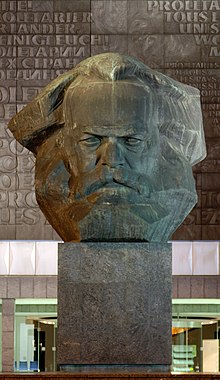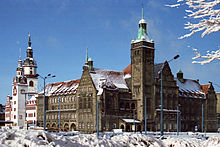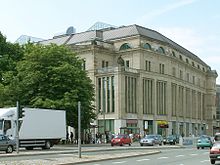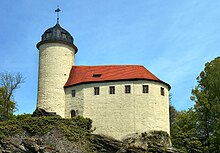Chemnitz
Chemnitz | |
|---|---|
| Country | Germany |
| State | Saxony |
| Admin. region | Chemnitz |
| District | urban district |
| Government | |
| • Mayor | Barbara Ludwig (SPD) |
| Area | |
| • Total | 220.85 km2 (85.27 sq mi) |
| Elevation | 296 m (971 ft) |
| Population (2008-12-31) | |
| • Total | 243,880 |
| • Density | 1,100/km2 (2,900/sq mi) |
| Time zone | UTC+01:00 (CET) |
| • Summer (DST) | UTC+02:00 (CEST) |
| Postal codes | 09001–09247 |
| Dialling codes | 0371 |
| Vehicle registration | C |
| Website | chemnitz.de |
(Sorbian: Kamjenica; from 1953–1990, known as Karl-Marx-Stadt) is the third-largest city of the Free State of Saxony, Germany. Chemnitz is an independent city which is not part of any county and seat of the government region Direktionsbezirk Chemnitz. Located in the northern foothills of the Ore Mountains, it is a part of the Saxon triangle metropolitan area comprising 3.5 million people. The city's economy is based on the service sector and manufacturing industry. The Chemnitz University of Technology has around 10,000 students and is the centre of scientific life.

Etymology
Chemnitz is named after the Chemnitz River, a small tributary of the Zwickauer Mulde. The word "Chemnitz" is from the Sorbian language and means "stony brook". In German, "Chemnitz" is pronounced [ˈkɛmnɪts]. It is known in Czech as Saská Kamenice.
History
An early Slavic tribe's settlement was located at Kamienica, and the first documented use of Chemnitz was the 1143 site of a Benedictine monastery, around which a settlement grew. Circa 1170 Frederick I, Holy Roman Emperor granted it the rights of an imperial city. In 1307 the town became subordinate to the margraviate of Meissen (the predecessor of the Saxon state). In medieval times Chemnitz became a centre of textile production and trade. More than one third of the population worked in textile production. By the early 19th century Chemnitz had become an industrial centre (sometimes called "the Saxon Manchester"). In 1913 Chemnitz had a population of 320,000 and is one of very few cities which were larger at that time than they are today.
During World War II, Chemnitz included factories that produced military goods and a Flossenbürg forced labor subcamp (500 female inmates) for Astra-Werke AG.[1] The oil refinery was a bombing target of the Oil Campaign of World War II, and Operation Thunderclap attacks included the following raids:





- 14/15 February 1945 The first major raid on Chemnitz used 717 RAF bombers, but due to cloud most bombs fell over open countryside.
- 2/3 - 5 March USAAF bombers attacked the marshalling yards.[2]
- 5 March 760 RAF attacked.
The WWII bombings left most of the city in ruins,[citation needed] and post-war, the East German reconstruction included large low rise (and later high-rise plattenbau) housing. Some tourist sites were reconstructed during the DDR era and after German reunification.
From 10 May 1953 to 21 June 1990, Chemnitz was named Karl-Marx-Stadt (English: Karl Marx City).
Sights
Tourist sites include the Kassberg neighborhood with 18th and 19th centuries buildings and the Karl Marx Monument by Lev Kerbel, nicknamed "Nischel" (a Saxonian dialect word for head, by the locals). Landmarks include the Old Town Hall with its Renaissance portal (15th century), the castle on the land of the former monastery, and the area around the opera house and the old university. The most conspicuous sight is the red tower which was built in the late 12th or early 13th century as part of the city wall.
A petrified forest can be found in the courtyard of Kulturkaufhaus Tietz. It is one of the very few in existence, and dates back several million years. Also within the city limits, in the district of Rabenstein, is the smallest castle in Saxony: Burg Rabenstein.
The town has changed considerably since German reunification. Most of its industry is gone and the core of the city has been rebuilt with many small shops as well as huge shopping centres. Many of these shops are of well known labels, including Zara, H & M, Esprit, Galeria Kaufhof, Leiser Shoes, Peek & Cloppenburg and so on. The large shopping centre "Roter Turm" (Red Tower) is very popular with young people.
The Chemnitz Industrial Museum is an Anchor Point of ERIH, The European Route of Industrial Heritage.
Newly opened (on December 1, 2007) is the "Museum Gunzenhauser", formerly a bank, which in recent months has been converted into a museum . Dr. Alfred Gunzenhauser, who lived in Munich, had a collection of some 2,500 pieces of modern art, including many paintings and drawings from Otto Dix, Karl Schmidt-Rottluff and others.
Urban renewal
Heavy destruction in World War II as well as post-war demolition to erect a truly socialistic city centre left the city with a vast open space around its town hall where once a vibrant city heart had been. Due to massive investment in out-of-town shopping right after reunification, it was not until 1999 that major building activity was started in the centre. Comparable only to Potsdamer Platz in Berlin, a whole new quarter of the city was constructed in recent years. New buildings include the Kaufhof Department Store by Helmut Jahn, Galerie Roter Turm with a facade by Hans Kollhoff and Peek&Cloppenburg Clothing Store by Ingenhofen and Partner.
Economy
Chemnitz is largest city of the Chemnitz-Zwickau urban area and is one of the most important economic regions of East Germany. Chemnitz had a GDP of about €6.3 billion in 2004. Since about 2000, the city's economy has generated record high annual GDP growth rates; thus, Chemnitz is among the top ten German cities with the highest growth rates. The local and regional economic structure is characterized by medium-sized companies with the heavy industry's sectors of mechanical engineering, metal processing, and vehicle manufacturing as the most significant industries.
Over several years, the unemployment rate has steadily decreased to 13.9% (Jul/2007). The number of employees amounts to about 100,000 including about 46,000 commuters from other municipalities.[3] 16.3 percent of employees in Chemnitz have a university or college degree, twice the average rate in Germany.
Demography

After the reunification of Germany Saxony faced a significant population decrease. Since 1990 Chemnitz lost more than 20 percent of the inhabitants. In 2006 the BBC reported the city of Chemnitz had the lowest birth rate in the world.[4]
Transport

Road
Chemnitz is crossed by the two motorways (Autobahn) A4 Erfurt – Dresden and A72 Hof – Leipzig. The motorway junction Kreuz Chemnitz is situated in the northwestern area of the city. The motorway A72 between Niederfrohna and Leipzig is still under construction. Within the administrative area of Chemnitz there are eight motorway exits (Ausfahrt).
Public transport
Public transport within Chemnitz is provided by the Straßenbahn (28.73 km [17.85 mi] net length) and Bus (326.08 km [203.32 mi] net length) —operated by the CVAG — and by the Stadtbahn (16.3 km [10.16 mi]). Nowadays, one Stadtbahn, five trams and 27 city buses, several regional bus lines, among them two express bus lines, run within Chemnitz and neighbouring municipalities. In the weekend and before bank holidays two bus lines, two tram lines and one Stadtbahn line run at night after midnight.
Since 30 March 2008 Chemnitz has a new structured tram and bus net. It is expected that the new net will consist of one Stadtbahn line, four tram lines, 23 bus lines and several further regional und express bus lines all the day. Between midnight and morning hours, eight night bus lines will serve the public transport in Chemnitz.
Airports
Near Chemnitz there are three airports among them the two international airports of Saxony in Dresden and Leipzig. Both Leipzig/Halle Airport and Dresden Airport are situated about 70 km [43.5 mi] from Chemnitz and offer numerous continental as well as intercontinental flights. The Leipzig-Altenburg Airport which is actually situated closer to Chemnitz (39 km [24.2 mi]) than to Leipzig (51 km [31.7 mi]) offers lines to London Stanstad (daily) and Barcelona Gerona (currently three times a week) operated by the Irish low cost carrier Ryanair.
Chemnitz also has a small commercial airport about 13.5 km [8.4 mi] south of the city. The so-called Verkehrslandeplatz Chemnitz Jahnsdorf is currently being upgraded. After completion it will have a runway of 1,400 m x 20 m (asphalt surface).
Sports
- Chemnitzer FC (Football)
- VfB Fortuna Chemnitz (Football) (first football club of Michael Ballack)
- Post SV Chemnitz
- Schwimmclub Chemnitz v. 1892 e.V.
- ERC Chemnitz e.V. (Icehockey, Skaterhockey)
- CTC-Küchwald (Tennis)
Famous residents
- Stefan Heym (1913–2001), author
- Helga Lindner, swimmer; Olympic silver medalist
- Max Littmann (1862–1931), architect
- Anja Mittag, footballer, World Champion 2007
- Sylke Otto, luger
- Frank Rost, football goalkeeper, currently playing for Hamburger SV
- Karl Schmidt-Rottluff (1884–1976), painter
- Ingo Steuer, figure skater
- Mandy Wötzel, figure skater
- Michael Ballack, footballer
Honorary citizens
- Karl Schmidt-Rottluff, painter, (1884–1976)
- Katarina Witt, figure skater, 12 gold medals at Olympic Games, World & European Championships
- Waleri Bykowski, cosmonaut
- Sigmund Jähn, cosmonaut
- Stefan Heym, author, (1913–2001)
International relations
Twin towns - Sister cities
Chemnitz is twinned with a number of cities around the world:
|
References
- ^ Victor, Edward. "Chemnitz, Germany". Retrieved 2009-03-23.
- ^ COMBAT CHRONOLOGY OF THE US ARMY AIR FORCES http://paul.rutgers.edu
- ^ Internetseite des Bundestagsabgeordneten Detlef Müller (SPD) mit Kennzahlen zur Chemnitzer Wirtschaft
- ^ "German births decline to new low". BBC NEWS.
- ^ "Twin Cities". The City of Łódź Office. File:Uk flag.gif
 (in English and Polish) © 2007 UMŁ. Retrieved 2008-10-23.
(in English and Polish) © 2007 UMŁ. Retrieved 2008-10-23.


